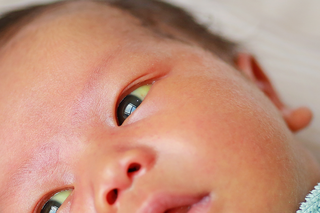what is jaundice in babies nhs
If high bilirubin levels are untreated they can cause serious problems. What is the normal level of jaundice in newborn babies.

Jaundice Lewisham And Greenwich Nhs
Bilirubin a product from the normal breakdown of red blood cells is elevated in newborns for several reasons.

. Jaundice in Babies Page 5 of 6 Advice and support can also be obtained from the following sources. Jaundice is the yellow color seen in the skin of many newborns. Your baby may have jaundice that lasts longer than your doctor or midwife expects.
Jaundice or heart failure eg. This is a pigment that settles in body tissues and can make your babys skin look yellow. Treatments for jaundice depend on whats causing it.
Physiological jaundice commonly appears. Newborn jaundice is a yellowing of a babys skin and eyes. Because a new-born babys liver is immature it cant get rid of bilirubin quickly.
The management of neonatal jaundice is a particular challenge to the neonatologist. Jaundice is very common in newborn babies and about nine out of ten of newborn babies will become jaundiced two or three days after birth. About 10 of breastfed babies are still jaundiced at one month.
Jaundice a sign of elevated bilirubin levels is common during the first weeks of life especially among preterm newborns. Jaundice is caused by the build-up in your body of a yellow substance called bilirubin. Bilirubin is a yellowish-red pigment that is formed and released into the bloodstream when red blood cells are broken down.
Jaundice is a yellow colouration of the skin and whites of the eyes that is common in newborn babies. Jaundice also called hyperbilirubinemia means that there is a high level of bilirubin in the blood. Jaundice is more common in boys than girls and in premature babies.
Thus a jaundiced baby is one whose skin. Measuring bilirubin levels in babies with jaundice. This leaflet explains what jaundice is and how it is treated.
Jaundice often occurs in newborns. Jaundice in newborn babies Your baby was referred because they are jaundiced. A common condition it can occur when babies have a high level of bilirubin a yellow pigment produced during the breakdown of red.
Prolonged jaundice is usually harmless but can be a sign of a serious liver problem. If so you and your doctor or midwife should look for pale chalky stools andor dark urine and further blood and urine tests will be needed. Jaundice comes from the French word jaune which means yellow.
Jaundice in older children however has other causes. Jaundice is common in the term newborn affecting between 60 of term and 80 of preterm babies in the first week of life. Neonatal jaundice in babies from 37 weeks gestation or above who are not already admitted to the neonatal unit and in the community maternity or paediatric setting.
Neonatal jaundice is the term used when a newborn has an excessive amount of bilirubin in the blood. Jaundice happens when a chemical called bilirubin builds up in the babys blood. Jaundice is very common in newborn babies.
Such babies can be treated as normal. Prolonged jaundice is when the yellowness of your babys skin and the whites of their eyes doesnt fade after 2 weeks in a full-term baby and after 3 weeks in a premature baby. In newborns jaundice usually occurs because an infants liver isnt fully developed enough to properly break down and excrete bilirubin.
Most jaundice in new-born babies is called ph ysiological jaundice because it is part of a normal body process. Poor feeding pallor tachypnoea sweating. In some babies the yellowing can be noticed in the whites of the eyes.
In most cases neonatal jaundice is nothing to worry about it requires no treatment and usually disappears after a week or so. In most babies jaundice is a physiological process that is harmless unless the bilirubin level reaches a critical value that can occur in rare cases. Maternal Anti-D Therapy Administration of anti-D immunoglobulin to the mother during pregnancy can result in DAT being weakly positive in the newborn.
Jaundice is not a liver disease. It occurs as a result of the liver being underdeveloped and not fully functional. Mild jaundice is a common and usually harmless feature of the neonatal period seen on a daily basis by staff in a huge variety of settings.
Jaundice is very common and develops in approximately 60 of term and 80 of preterm infants in the first week of life. There are lots of possible reasons for this and some of them are serious. Jaundice is caused by the liver not being fully developed and not yet fully functioning properly.
Why is my baby jaundiced. During pregnancy the mothers liver removes bilirubin for the baby but after birth the babys liver must remove the bilirubin. Jaundice happens because the liver has to break down old red blood cells from the bloodThis process produces a waste product called bilirubin.
Parents should be advised to seek midwiferyGP review if significant jaundice develops. The skin of a baby with jaundice will look slightly yellow. Jaundice is a name given to the yellow appearance of the skin and the whites of the eyes.
Ad What causes jaundice in newborns and how is it treated. Español Spanish minus.

Jaundice In Babies Babycenter Australia

Newborn Jaundice Babycenter India

Jaundice Lewisham And Greenwich Nhs

Jaundice In Newborn Babies Health
Newborn Baby Jaundice Jaundice Causes Symptoms Waterwipes Us


